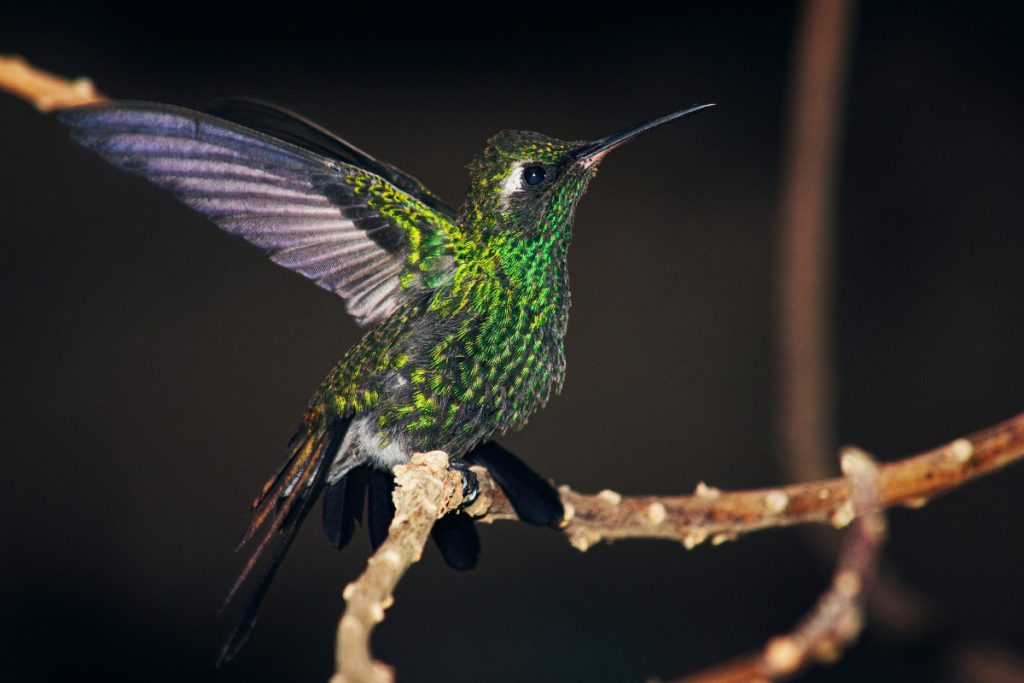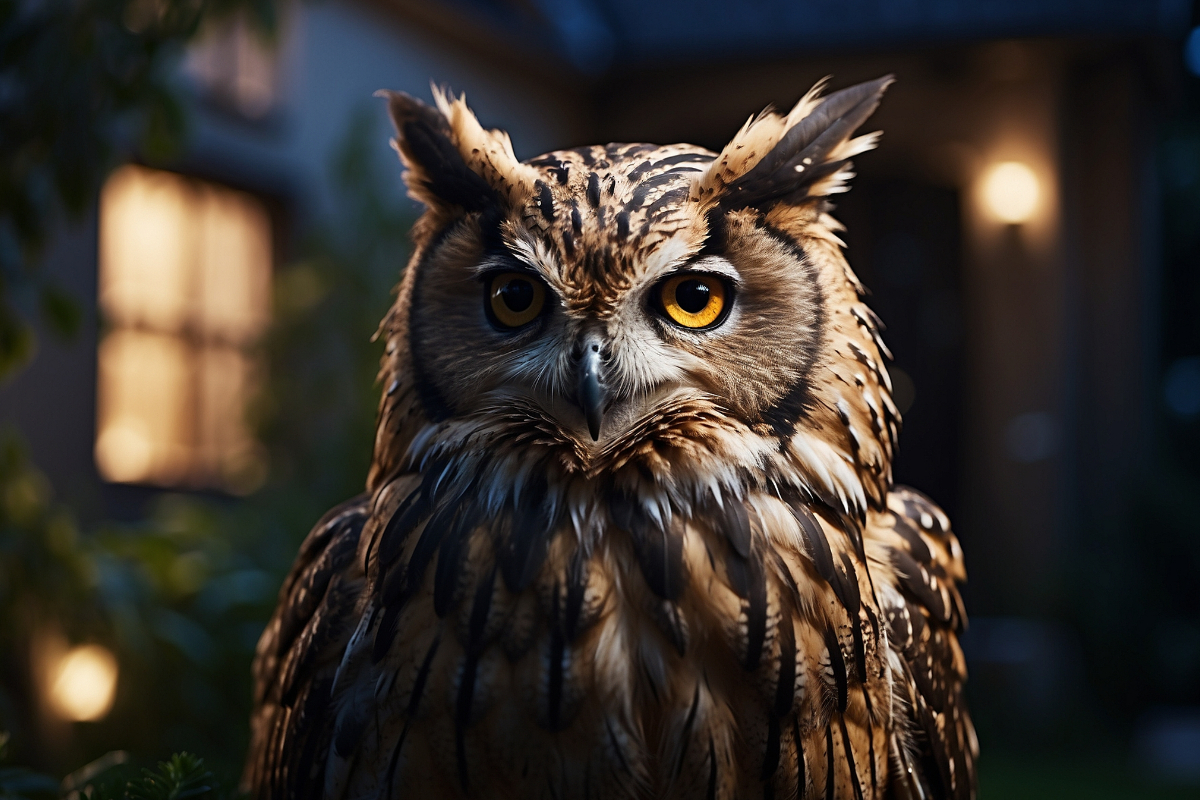Yes, some owl species do hunt and eat hummingbirds at night. The Great Horned Owl is one of the main culprits, as it is a large and powerful predator with a varied diet that includes small birds.
These nocturnal owls are known to opportunistically prey on sleeping hummingbirds, especially during migration seasons when the populations mix more frequently.
The reason owls go after tiny hummingbirds is that the hummingbirds are vulnerable when they enter a hibernation-like state called torpor at night to conserve energy. In this state, their metabolic rate and body temperature drop dramatically, leaving them easy targets for stealthy owl predators.
Owls have several key adaptations that give them an advantage, such as silent flight, powerful talons, and excellent low-light vision, which allow them to detect and capture the otherwise quick and agile hummingbirds.
Related post to read: Where Do Hummingbirds Go at Night?

Understanding Why Owls Hunt Hummingbirds At Night
The Great Horned Owl is one of the most common owl species found across the Americas. As a large and powerful predator, they have a varied diet ranging from small rodents up to the size of skunks and cats. Great Horned Owls and other nocturnal owl species are known to opportunistically prey on sleeping hummingbirds, especially during migration seasons when the populations mix more frequently.
So why would an owl go after a tiny hummingbird? Quite simply, they make for easy pickings while sleeping. Hummingbirds have extremely high metabolisms and cannot go long without food to fuel their energy needs. To conserve energy overnight, they go into a hibernation-like state called torpor, where their metabolic rate and body temperature drop dramatically. This leaves them vulnerable to predators.
Owls have several key adaptations that give them an advantage in capturing the otherwise quick, agile hummingbirds:
- Stealth – Their specially adapted feathers enable silent flight. This allows them to sneak up on unsuspecting sleeping hummingbirds.
- Powerful talons – Great Horned Owls have extremely strong gripping power in their talons, with forces over 300 psi documented. This allows them to instantly kill small prey.
- Excellent low light vision – Owls have outstanding night vision with extra rod cells in their eyes, allowing them to detect even subtle movements. Their satellite dish-like faces also enhance directional hearing to pinpoint sleeping hummingbirds.
So, when hummingbirds are active and alert, their speed and manoeuvrability provide strong defences against predation. But in their sleeping state, they can fall victim to marauding owls under the cover of darkness.
Fascinating Bird Abilities
Both owls and hummingbirds boast some fascinating evolutionary adaptations:
Owls
- Silent flight from specialised feather design
- 360-degree head rotation thanks to extra vertebrae
- Asymmetrical ear placement for directional hearing
- Extremely powerful feet and sharp talons
Hummingbirds
- Beating wings up to 80 times per second! Enabled by shoulder joints that rotate 360 degrees
- Reversing direction in an instant by altering the angle of their wings
- Iridescent, light-reflecting plumage for camouflage and mating displays
- Long, specially adapted tongues to feed on nectar while hovering
- High-speed dives and climbs to evade predators
These superb bird abilities showcase the power of evolutionary adaptation. Owls have honed the ultimate stealth hunting abilities, while hummingbirds have specialised in agile manoeuvring and hover-feeding.

Likelihood of Hummingbirds Becoming Prey
While Great Horned Owls and other nocturnal predators do catch hummingbirds, some key factors limit how often it happens:
- Many owl species prefer small mammal prey like mice and voles rather than avian prey
- Hummingbirds have evolved camouflage for sleeping, making them hard to spot
- Their sheer speed and manoeuvrability lower the chances of capture while active
- Owls hunt by sight and sound – hummingbirds make very little noise while perching
- Hummingbird populations have boomed with backyard feeders providing food sources
So, while owls are certainly capable of preying on hummingbirds, various evolutionary adaptations of both species mean documented cases are relatively rare. The risks appear to be highest when hummingbirds are sleeping, migrating or facing limited food sources.
Conclusion
In the high-stakes evolutionary arms race, owls have developed superb stealth hunting skills to capture agile prey like hummingbirds under the cover of darkness. For hummingbirds, their best defences come from their speed and manoeuvrability while active and camouflage while at rest.
While owls do opportunistically prey on hummingbirds, numerous adaptations of both species have limited this from becoming a frequent occurrence.
So hummingbird watchers can enjoy these aerial masters, knowing their marvellous abilities provide strong defences against predators like prowling owls that hunt under the cloak of night.
Useful Links:
Related Posts to Read:
- 25 Hummingbird Behaviors.
- Do Hummingbirds Beaks Open When Feeding?
- 6 Fascinating Facts About Hummingbird Sizes.
- Hummingbird Diet and Nutrition.
- How Much Does A Hummingbird Eat Per Day?
- Do Hummingbirds Eat Bees?
- Do Hummingbirds Eat Wasps?
- Where Do Hummingbirds Go in the Winter?
References:
- About Hummingbird (Link).
- Greenewalt, C. H. (1960). Hummingbirds. New York: Doubleday. Google Scholar.
- Carey C. The impacts of climate change on the annual cycles of birds. Philos Trans R Soc Lond B Biol Sci. 2009 Nov 27; 364(1534):3321-30. doi: 10.1098/rstb.2009.0182. PMID: 19833644; PMCID: PMC2781852.
- Rico-Guevara A, Rubega MA, Hurme KJ, Dudley R. Shifting Paradigms in the Mechanics of Nectar Extraction and Hummingbird Bill Morphology. Integr Org Biol. 2019 Jan 2;1(1):oby006. doi: 10.1093/iob/oby006. PMID: 33791513; PMCID: PMC7671138.
- Tyrrell LP, Goller B, Moore BA, Altshuler DL, Fernández-Juricic E. The Orientation of Visual Space from the Perspective of Hummingbirds. Front Neurosci. 2018 Jan 30;12:16. doi: 10.3389/fnins.2018.00016. PMID: 29440985; PMCID: PMC5797624.
- Hummingbirds Sighting (Journey North Map).
- About Hummingbird’s Characteristics.
- About the Origins of Hummingbirds.
